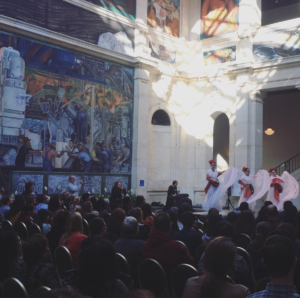
The Detroit Institute of Arts is the anchor for a network of museums, schools, galleries, and institutions that create Detroit’s thriving art community. It is a place where one can experience the incredible power that art has to evoke empathy and cross cultural understanding. The DIA famously houses the largest example of Mexican mural art in the United States. These epic scale murals depict factory workers in a landscape of automotive technology showing the many faces of an industry indigenous to Detroit.
During a recent visit to DIA, after seeing the murals, I wander in the direction of the famous Rivera Court and hear the soft echoing of music. Out of the corner of my eye, I see a flurry of traditional white pueblan skirts flying in front of a backdrop of cool-toned frescos. A crowd of proud dance parents and suburban visitors clap together to the rhythm of the Mexican Hat Dance as the youngest performers of Detroit’s Ballet Folklorico troop spin in an oblong circle. To my right, a colorful, mysterious glow escapes from the entry to an exhibition. The exhibition entitled “Ofrendas: Celebrating Dia de los Muertos,” is a collaboration with the Mexican consulate that invites Detroit artists to create unique ofrenda alters for the museum. The alters, like the one created by artist Kia Arriaga in the first room, educate visitors on the tradition and symbolic elements of the ofrenda. In the second room, visitors kneel before a traditional seven-step altar to read the names of the victims of Detroit’s Delray neighborhood pollution. The last room of the exhibition employs a large format projector in a social media campaign that invites Detroiters to participate in a collective ofrenda by submitting pictures of their deceased loved ones.
Exhibitions that reflect the cultural diversity of cities are becoming more common. Franklin Sirmans, director of the Perez Art Museum in Miami, spoke in Detroit recently about the necessity for museums to meet community members on their level in order to provide exhibitions that make people feel the museum is for them. This sentiment translates into the architecture of the PAMM. The museum’s large porch provides a natural gathering place that is given back to the city and its transparent glass facades break down barriers. Sirmans has also brought in artists like Doris Salcedo whose work resonates with the largely immigrant population of Miami. Sirmans aims to create a prototype for a responsive museum that adapts to the political and social environment of a city.
Public museums have an active role in facilitating cultural exchange. Museums make art available to everyone; good museums use art to bring a city together. Open and accessible museums begin with thoughtful programming that goes beyond the popular blockbuster crowd drawers. Don’t let the monumental facade and steps of DIA fool you. Today, it is the art inside the walls that matters most.
